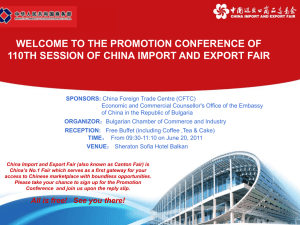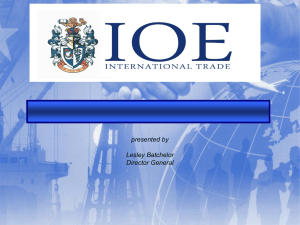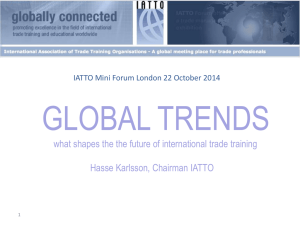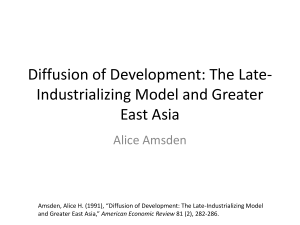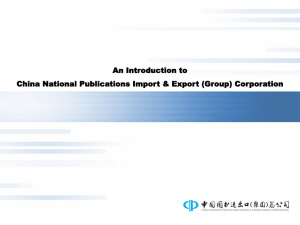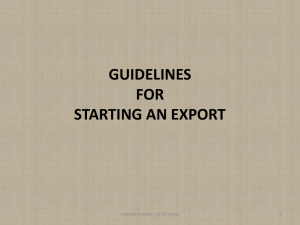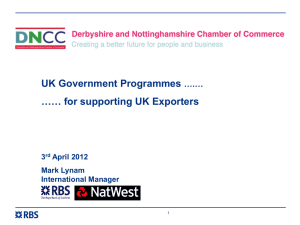Recommending a Strategy
advertisement
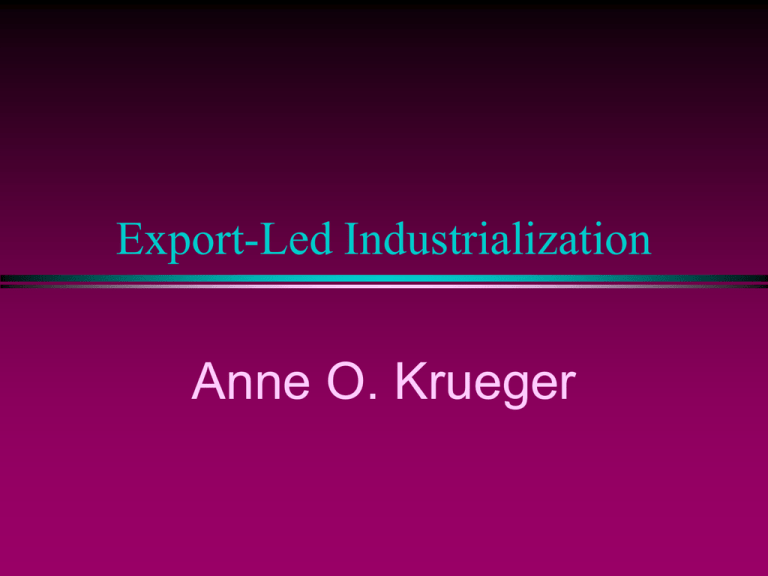
Export-Led Industrialization Anne O. Krueger She is Krueger Development Countries trade policies have fallen into two distinct groups A. Import substitution: Those countries which have adopted trade policies which diverge from the optimality criterion that International Marginal Rate of Transformation (IMRT) = Domestic Marginal Rate of Transformation (DMRT) by a large amount, by protecting their domestic markets. B. Export promotion: Export Led Growth consisting of encouragement to exports, usually beyond the point that IMRT = DMRT. Countries adopting this strategy have generally experienced rapid growth of traditional exports, but even more rapid growth of nontraditional exports. What is export-led growth/outward oriented/export promotion/export substitution? A. All terms refer to policies of countries successful in developing their export markets. B. Common features -most analysts agree that an ELI strategy is one there: 1). There is at least as much incentive to earn as to save foreign reserve. 2). Interventions are generally in the form of incentives rather than imposition of direct controls. 3). Incentives to export are fairly uniform and not discriminatory across commodity groups. 4). There is no bias of incentives toward production of import substitutes. 5). The incentives which do exist must favor production for export as much as, if not more than, the production for the domestic market. Three main results emerging from experiences of ELI countries Remarkable rates of growth associated with growth of exports. For all countries where it was possible to contrast performance before and after the policy changes, the growth rate clearly jumped shortly after ELI adoption. Sustained high growth rates indicated that outwardoriented policies created dynamic effects in the economics and did not merely produce static gains from improved allocation of resource. ELI Vs. ISI Experience has been that growth performance has been more satisfactory under export promotion strategies than under importsubstitution strategies. The relationship between export performance and growth is sufficiently strong that it seems to bear up under many different specifications of the relationship. It has been tested over many countries for: (1) rates of growth of real GNP and of export; (2) for real GNP net of exports and exports; and (3) for rates of growth of real GNP as a function of rate of capital formation, aid receipts, and export growth. Success stories: Korea, Taiwan, Brazil are well known, Also Turkey and Philippines did, so that there is little double about link between export performance and growth rates. Three hypotheses of why such a difference in Goth performance should be associated with export promotion. HYPOTHESES 1: technological-economic factors imply an overwhelming superiority for development through export promotion. Asserts that gains from trade, especially for developing countries, are so sizable that losses associated with import substitution significantly reduce the rate of return on factor accumulation. A failure to take advantage of the opportunities to exploit these phenomena through trade significantly impairs the attainable rate of growth. a. Size of markets - Under ELI policies, efficient activities can expand well beyond the size of the domestic market. Expansion of an activity beyond the amount sold in the domestic market becomes profitable. Continues…... b. Indivisibility and economies of scale - export oriented strategies permit a developing country, regardless of the size of its domestic market, to establish plants of economically efficient size and to maintain long production runs. c. Factor intensities - developing countries are usually relatively endowed with unskilled labor. The rate of human and physical capital formation is the constraint upon expansion of the industrial sector in these countries. d. Infant industries - this argument has long been used to justify protection. However in ELS, if there are infant industries, once developed they can be expanded well beyond the size of the domestic market. e. Interdependence and quality - efficient production of most manufactured goods entails the use of a wide variety of inputs. Under ELI, exporters have access to their intermediate inputs. f. Economic behavior. Hypothesis 2 Differences in growth rates have resulted, not from the choice of trade strategy per se, but rather from excesses in the ways in which import substitution policies were administered. 1). The failure of import substitution resulted from excesses of the particular ways in which domestic industries were encouraged: for example, currency overvaluation, quantitative restrictions, techniques of allocating import licenses. 2). One cost was the failure of export earnings to grow as much as they would under better import policies. a. Led to stop-go patterns b. Foreign exchange bottle neck emerged. Hypothesis 3 Policies adopted in pursuit of an export promotion strategy are generally far closer to an optimum, both in the DMRT = IMRT sense and with respect to the domestic market, than are those adopted under import substitution. The role of trade policy is to constrain policymakers in such a way that they do not impede the growth rate as much as they otherwise would. 1). ELI strategies imposes constraints on policymakers, both in what they can attempt to do and in making them aware of the costs of mistakes. 2). Policymakers receive feedback in a relatively short time period as to the costs of their policies. 3). It is infeasible o rely upon quantitative controls: the international price, at least, can not be administered and to that extent, more generalized forms of incentive, including a relatively realistic exchange rate, must be employed. Conclusions Experience has clearly demonstrated the importance of access to international markers in providing a means of permitting more rapid growth than would otherwise be feasible. Given the enormous difficulties and costs of achieving institutional and other changes that economic growth requires, it is probable that trade policy changes have a higher rate of return to LDCs than most other feasible policy changes. The fact of openness itself, rather than of export growth, is a critical ingredient for rapid increases in output and productivity. This consideration is significant in evaluating the prospects for future growth of developing countries in the context of a potentially slower expansion of world trade -- if it is openness itself that conveys benefits due to competition and the future of policy instruments employed, the gains from export orientation will be almost as great with slower growth of world trade as with more rapid growth. Summary Process of ELI 1.Tariff can not induce production for the international market, therefore export subsidies or a realistic exchange rate is required. 2. There is a tendency to maintain a realistic exchange rate. 3. This encourage exports and reduces the balance of payment motive for tariff protection. 4. Exporting industries must be permitted to purchase their needed. intermediate goods and raw materials at world prices to be competitive. 5. This puts pressure on authorities to reduce barrios to imports, which in turn may encourage other producers to enter the export market. 6. A effective export promotion policy must be accompanied by a fairly open and liberalized trade regime. Is it ELI better than Import substitution No, we can not say that!! In last thirty years, ELI got big success, but we can not say which policy is better of not, it is depend on in which country and in which time period. The End Thank you!



